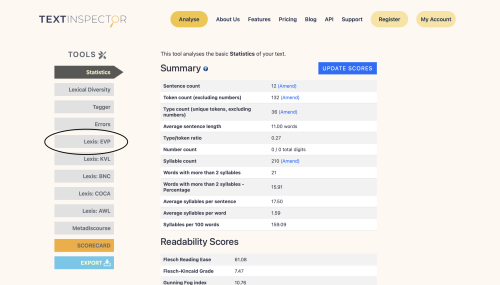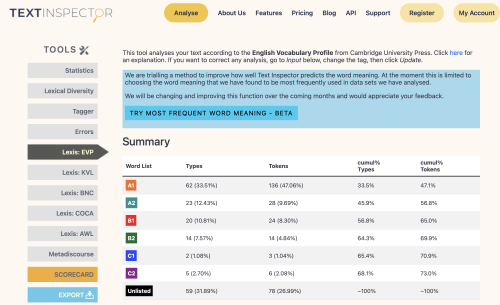– English Vocabulary Profile (EVP) –
Analysing the CEFR level of Vocabulary using the English Vocabulary Profile (EVP)
Text Inspector has joined with Cambridge University Press to produce a tool for analysing your texts in terms of the English Vocabulary Profile (EVP), part of the English Profile project.
This allows you to identify the level of each word, phrase, idiom and collocation found in the text according to the CEFR (Common European Framework of Reference) on a scale of A1-C2 (See an explanation of the CEFR here).
This tool can be used to help improve learning and teaching.
[Note: The tool currently only has the UK version of the EVP. In future it will also have the US version]
What is the English Vocabulary Profile?
The English Vocabulary Profile (EVP) is a reference that contains information about which words, phrases, idioms and collocations are used at each level of English learning.
This ground-breaking project was based on collaborative research conducted by two departments of the University of Cambridge, UK: Cambridge University Press and Cambridge English Language Assessment.
The project was based on the Cambridge Learner Corpus (CLC), a collection of hundreds of thousands of examination scripts from English language learners across the world to help analyse texts in terms of their CEFR level.
By using this tool, ESOL teachers and curriculum creators can understand what aspects of English language are typically learned at each CEFR level.
This can help in the development of curricula, course materials and lesson plans with this information in mind.
Where do I find the English Vocabulary Profile information in the analysis?
Once you’ve analysed the text, you’ll immediately see a full summary of the analysis.
To access the information relating to the EVP, look at the left side of the page and click the tab that is labelled ‘Lexis: EVP’

[Note that you need to have a full subscription to access this advanced information]
You will then see a range of detailed information.
This includes a detailed summary of the text according to the CEFR (Common European Framework of Reference) levels A1-C2 and will be broken down into tokens and types.

You can also see details of the words analysed in each level, like this:

The tool gives the LOWEST analysis by default. For example, the word ‘hunt’ in the EVP could be either:
1). B1 verb (CHASE to chase and kill animals)
2). B2 verb (SEARCH to search for something or someone)
3). C2 noun (a search for something or someone)
The tool by default chooses B1 which in this text is correct.
But if you want to change an analysis you can click on the word in the text and select an alternative, like this:

Fed up of reading?